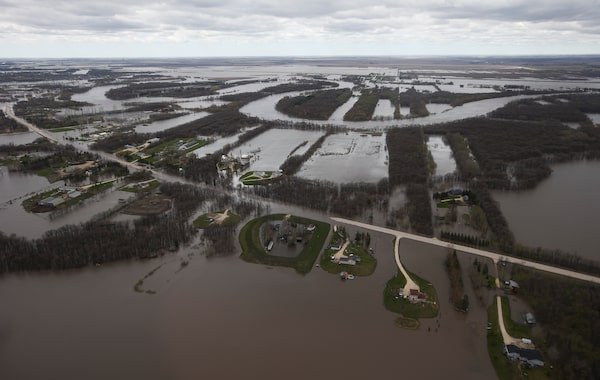
St Mary’s Road, which runs between Winnipeg and St Adolphe, Man., is closed due to Red River flooding south of Winnipeg on May 15. Dozens of experts advising the government on adapting to climate change say Canada's new adaptation strategy must move faster.JOHN WOODS/The Associated Press
The federal government says that by 2030 it wants to be able to return victims of climate disasters to normal life within one year of a weather event. As part of a sweeping climate adaptation plan under development, it also hopes to stop biodiversity loss by the end of the decade.
In Montreal on Monday, Environment and Climate Change Minister Steven Guilbeault launched public consultations and released a discussion paper on the adaptation strategy, which was first promised in the government’s 2020 climate change plan. The goal is to have the final strategy ready for the United Nations climate summit in November, known this year as COP27.
The task ahead is immense, experts say. Work to ensure communities are ready to weather the worst effects of climate change has taken a back seat to trying to limit global warming by cutting emissions.
In his opening statements, Mr. Guilbeault repeatedly cited the two tracks that his government needs to navigate, describing mitigation and adaptation strategies as playing “both offence and defence” and “fighting a war on two fronts.”
Already in the past few years, climate change has cost the country an estimated $30-billion, he said. The government’s discussion paper catalogues the recent deadly heat waves, devastating forest fires and flooding from rare atmospheric rivers in B.C. to highlight the need to “prepare for the unavoidable impacts of climate change.” Ottawa says the strategy will provide a blueprint for the country as it braces for more frequent and severe climate disasters and extreme weather.
The government is proposing a set of goals for 2030 and 2050 under the areas of health and well-being, the natural environment, infrastructure, the economy, and disaster resilience. The suggested adaptation measures include stopping home construction on floodplains, increasing tree coverage in urban areas to reduce the impact of heatwaves, and using data to map and manage wildfires.
Ottawa goes public with its planning to brace for climate change’s consequences
Blair Feltmate, the head of the University of Waterloo’s Intact Centre on Climate Adaptation, said that while Monday’s developments mark a step in the right direction, Ottawa’s proposed plan lacks a sense of urgency.
“Canadians aren’t going to be patient, waiting till 2030 or 2050,” said Prof. Feltmate, who is among those advising the government on the strategy, particularly in the areas of disaster resilience and security. “They’re thinking, ‘Look, I’m being flooded now.’ We’ve got people dying from extreme heat. We’ve got fires increasing in frequency and magnitude across the country. What are you going to do – now – to mitigate the risk?”
What’s missing, he said, is a short-term adaptation strategy covering the next five years. One thing the government could do today is launch a national home flood protection education program, he said, noting that tens of thousands of residences in Canada experience flooding each year at an average insurable cost of $20,000. Those numbers could be greatly reduced if homeowners took a few simple steps, including ensuring their sump pumps are in working order before a storm hits and installing plastic covers over ground-level window wells to keep water from flowing into a basement.
Among the most concrete goals spelled out in the discussion paper is a proposal to ensure that by the end of the decade, Canada will be able to return anyone affected by a climate disaster to normal life within one year of the event. The government says this goal could be met by either relocating people or by making community investments.
Canada has no standard timeline for restoring normal life after a disaster, departmental officials said. However, the experience of Lytton, B.C., suggests a one-year timeline may prove ambitious.
Late last June, the Fraser Canyon village hit nearly 50 degrees and was then razed by a heat-wave fuelled wildfire the next day. Nearly one year later, restoration work has yet to begin. Debris removal just started a couple months ago. It could be another year before power is fully restored to the town.
The government is also suggesting a timeline of 2050 to ensure that “all infrastructure systems in Canada are climate-resilient.” For example, in the North, buildings will need to be able to withstand melting permafrost; in southern parts of the country, building materials will need to change to hold up against temperature extremes.
Recognizing that nature is an important tool in the adaptation toolbox, the government is proposing to halt and reverse biodiversity losses by 2030 and see nature “fully recovered” by 2050. Wetlands, for example, are critical to storm-water management, and vegetation provides reprieve from the urban heat island effect – a phenomenon in which artificial surfaces such as concrete absorb and re-emit the sun’s heat more than natural landscapes, causing localized warming.
What “fully recovered” means and the baseline it would be measured against still needs to be defined, said Ian Mauro, executive director of the Prairie Climate Centre at the University of Winnipeg.
Prof. Mauro, who took part in the advisory panel for the adaptation strategy’s natural environment section, said Monday’s launch marks an important step in catching up on adaptation policy, but it is unfortunate the government’s work is still nascent. He warned against “hollow rhetoric” that in the past has led to little action.
Adapting to climate change will require a dramatic turnaround in approach, he said. “We have to be flawless.”
For subscribers: Get exclusive political news and analysis by signing up for the Politics Briefing.